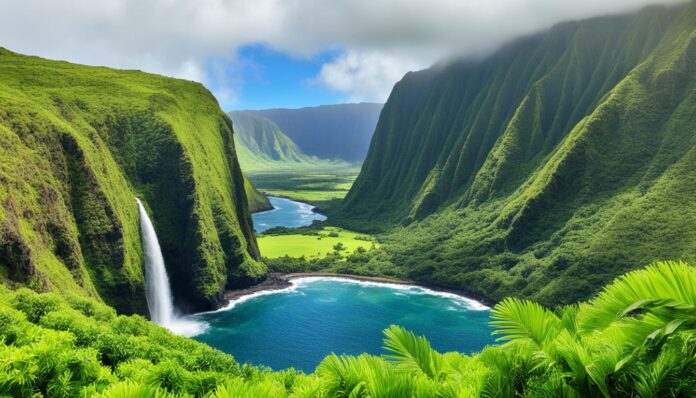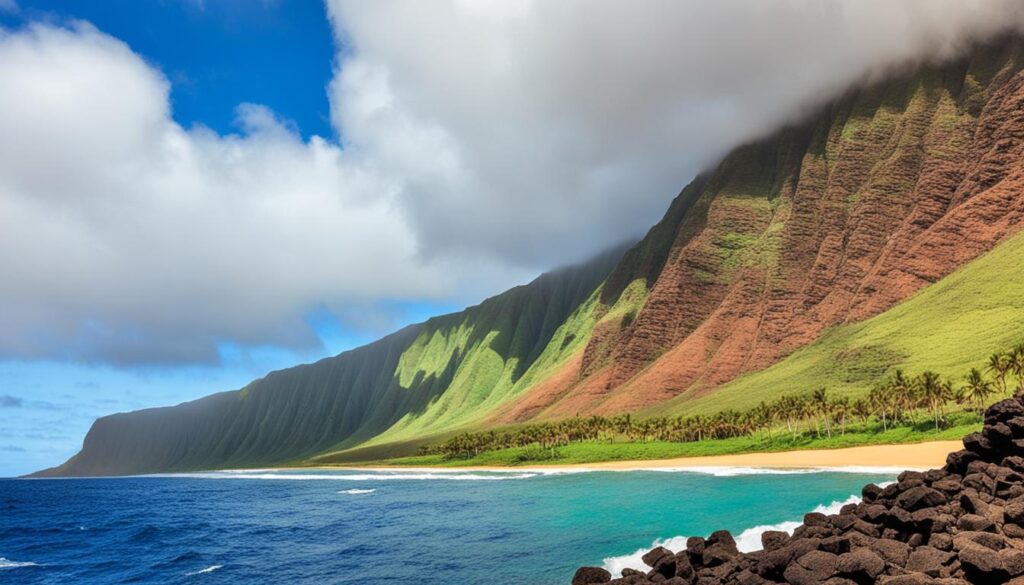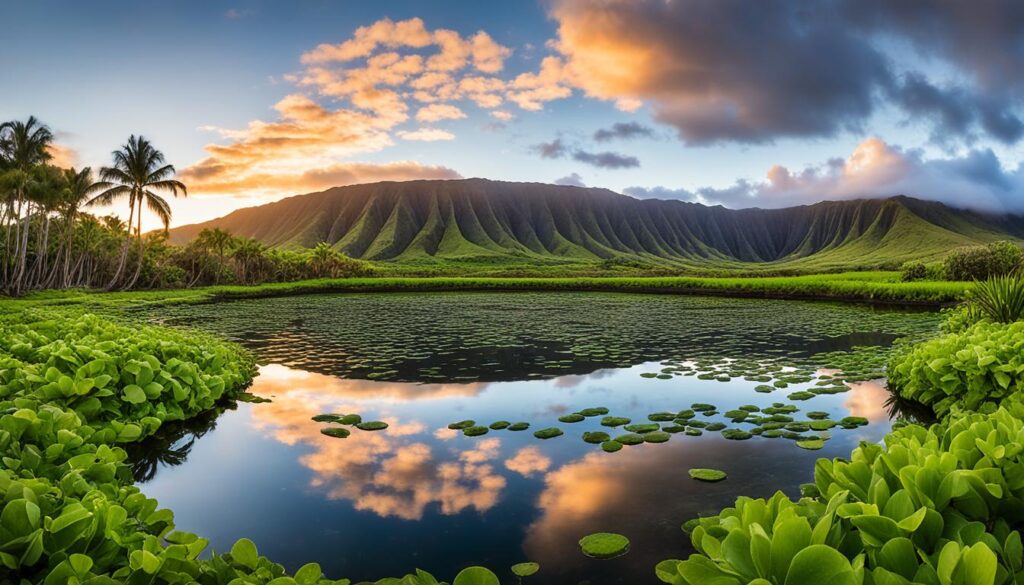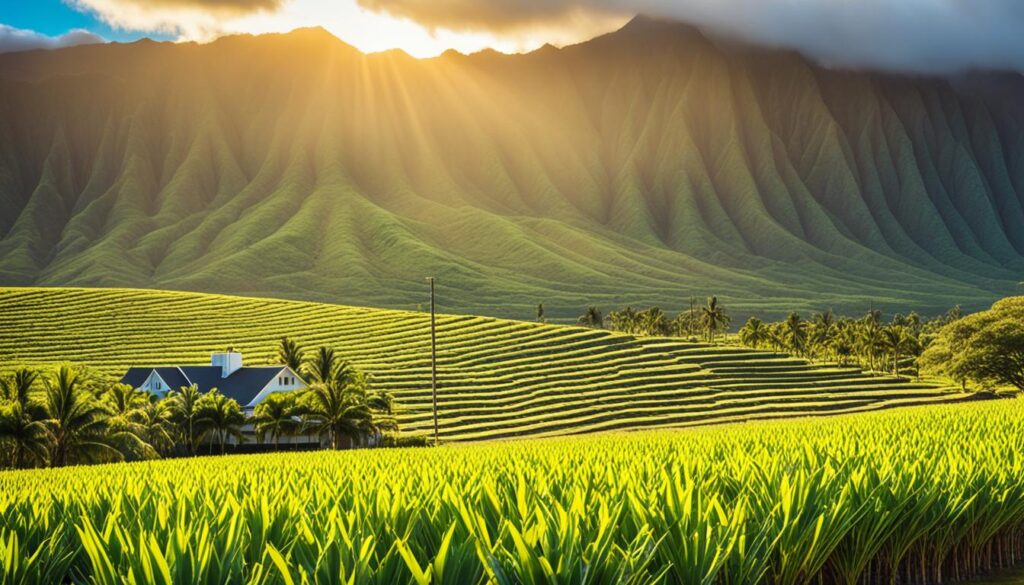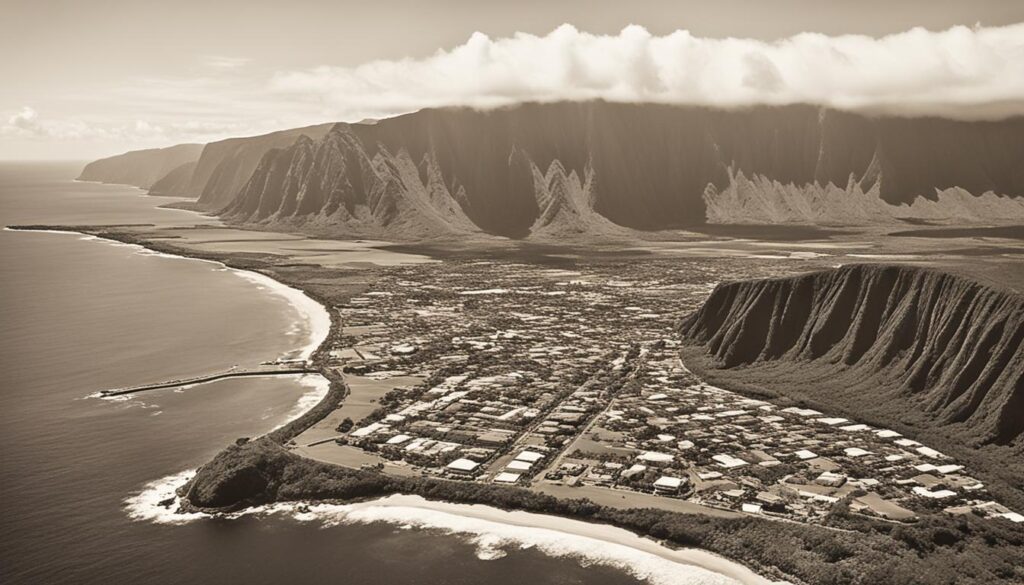Have you ever wondered what stories lie beneath the surface of Molokai, the lesser-known Hawaiian island? From ancient temples to the remains of the sugar and pineapple plantations, Molokai’s historic landmarks and sites hold the key to unlocking its fascinating past. Immerse yourself in the rich heritage and captivating history of Molokai as we take you on a journey through its top historic sites.
But before we delve into the must-visit landmarks and hidden gems, let’s explore the deep layers of Molokai’s unique history. Uncover the ancient traditions, connect with Hawaiian legends, and understand the island’s cultural significance. Are you ready to discover the secrets that Molokai has to offer? Let’s embark on an unforgettable journey through time and explore the hidden treasures of Molokai’s past.
Uncovering Molokai’s Unique History
When exploring Molokai, it’s impossible to overlook the island’s fascinating history. From ancient settlements to colonial influences, Molokai’s past has shaped its rich cultural heritage. Understanding the historical context of this enchanting island is essential to fully appreciate its unique charm.
Throughout its history, Molokai has witnessed significant events that have shaped the island’s identity. From the arrival of Polynesians and their establishment of thriving communities to the impact of European contact, each era has left its mark on the land and its people.
“Molokai’s history is a tapestry of diverse cultures and traditions woven together,” says Kahu Blessing, a local historian. “By uncovering the layers of the past, we gain a deeper understanding of the island’s essence.”
Historical places in Molokai serve as windows into the island’s past, offering visitors a glimpse into the lives of ancient civilizations and early settlers. These sites provide invaluable insights into the customs, traditions, and achievements of Molokai’s people.
One such historical place is Pu’u O Hoku Ranch, a picturesque estate nestled in the uplands of Molokai. With its preserved buildings and lush landscapes, the ranch offers a glimpse into the island’s ranching history and the legacy of its early settlers.
Molokai’s unique history is also reflected in its traditional fishing practices. The Molokai Fishponds, such as Kaupapa Fishpond, are a testament to the resourcefulness and ingenuity of the island’s ancient inhabitants. These intricate systems of walls and fish gates speak to the interconnectedness between humans and nature.
The Impact of the Kalaupapa Settlement
One of the most profound chapters of Molokai’s history is the Kalaupapa settlement. Established in the 19th century as a place of isolation for individuals affected by leprosy, Kalaupapa holds great historical and cultural significance.
Kalaupapa National Historical Park stands as a poignant reminder of the challenges faced by those who lived there and their enduring strength and resilience. It provides a platform to honor their stories and preserve their memory for future generations.
The Cultural Mosaic of Molokai
Molokai’s history is a vibrant tapestry of diverse cultures, each contributing to the island’s unique character. The indigenous Hawaiian culture is deeply rooted in Molokai, with ancient traditions and practices still celebrated today.
The frequent arrival of immigrants from various parts of the world further enriched Molokai’s cultural mosaic. Alongside Hawaiian customs, one can also discover elements of Portuguese, Filipino, and Chinese heritage, woven seamlessly into the fabric of the island.
| Historical Place | Description |
|---|---|
| Kamakou Preserve | Ancient rainforest preserving unique native flora and fauna. |
| Halawa Valley | Ancestral home of Native Hawaiians, steeped in legends and lush natural beauty. |
| Kalaupapa National Historical Park | Former leprosy settlement, a testament to the strength and resilience of its residents. |
By exploring historical places in Molokai, visitors can immerse themselves in the island’s rich heritage, gaining a deeper appreciation for the people and events that have shaped its history. From archaeological sites to preserved landmarks, Molokai offers a captivating journey through time.
Must-Visit Historic Landmarks in Molokai
When exploring the enchanting island of Molokai, be sure to visit its remarkable historic landmarks that showcase the island’s rich heritage and cultural significance. From breathtaking natural wonders to iconic architectural marvels, Molokai offers a wealth of must-see sites for history enthusiasts and tourists alike.
Kamakou Preserve
Located in the heart of Molokai, Kamakou Preserve is a pristine nature reserve that also holds great cultural and historical importance. This extraordinary site is home to diverse flora and fauna and provides visitors with a fascinating glimpse into the island’s ancient past. Explore the lush trails and immerse yourself in the natural beauty of Molokai’s upland rainforests.
Halawa Valley
Halawa Valley is not only a place of breathtaking beauty but also a cherished site for the local community. This lush valley holds deep historical significance, providing a glimpse into the traditional Hawaiian way of life. As you venture through the valley, you’ll encounter sacred sites, ancient taro patches, and stunning waterfalls that have captivated visitors for centuries.
Kalaupapa National Historical Park
Kalaupapa National Historical Park is a place of remembrance and reflection. This site holds the stories of those who lived in the remote settlement of Kalaupapa, which served as a leprosy colony in the past. Take a guided tour to learn about the challenges faced by the residents and the resilience they displayed in the face of adversity. Discover the history and cultural significance of this remarkable place.
Immerse yourself in Molokai’s fascinating history and marvel at the architectural wonders and natural landscapes that have shaped the island over time. These must-visit historic landmarks in Molokai offer an extraordinary journey through the island’s past, providing a deeper understanding of its cultural heritage.
Preserving Molokai’s Cultural Heritage
Preserving Molokai’s cultural heritage is of utmost importance to the island’s residents and authorities. Efforts are constantly made to maintain traditional practices, protect cultural sites, and ensure that visitors have the opportunity to experience the authentic culture of Molokai.
One of the key ways the cultural heritage of Molokai is preserved is through the preservation of its cultural sites. These sites are not only important historical landmarks but also offer valuable insights into the traditions and way of life of the people of Molokai.
Molokai Heritage Sites:
- The Kalaupapa National Historical Park: This park is a significant site that preserves the history of the leprosy settlement and tells the stories of the people who lived there.
- Puukohola Heiau National Historic Site: This sacred site was built by King Kamehameha I and is where he unified the Hawaiian Islands.
- The Molokai Fishponds: These ancient fishponds are a testament to the advanced aquaculture practices of the Native Hawaiians.
In addition to preserving cultural sites, Molokai also offers a variety of tourist attractions that showcase the island’s unique culture. Visitors can immerse themselves in the rich heritage of Molokai through cultural experiences such as hula performances, traditional arts and crafts demonstrations, and storytelling sessions.
By preserving Molokai’s cultural heritage and promoting it as a tourist attraction, the island ensures that future generations can continue to learn about and appreciate the traditions and history of the island.
“Preserving cultural heritage is not just about preserving the past; it is about ensuring a vibrant and meaningful future for our community and the generations to come.” – Molokai Cultural Preservation Society
A Journey Through Molokai’s Ancient Past
Embark on a fascinating journey through the ancient past of Molokai, where history comes alive through its remarkable historical sites. Discover the secrets and cultural significance of the Molokai Fishponds and the Ala Kahakai National Historic Trail.
The Molokai Fishponds
Named as one of the most impressive engineering feats in ancient Hawaii, the Molokai Fishponds are a testament to the ingenuity and resourcefulness of the native Hawaiians. These fishponds, known as ‘loko i’a’ in Hawaiian, served as sustainable aquaculture systems that allowed for the cultivation and preservation of fish.
Constructed using volcanic rock walls, the fishponds were designed to allow the flow of seawater while preventing larger fish from escaping, thus enabling the growth of smaller fish for consumption. The Molokai Fishponds represent a sustainable and harmonious relationship between the people and the ocean, showcasing the islanders’ deep connection to their natural surroundings.
The Ala Kahakai National Historic Trail
Uncover the history and cultural significance of the Ala Kahakai National Historic Trail, a 175-mile trail that winds through the rugged coastline of Molokai. This ancient trail, which translates to ‘trail by the sea’ in Hawaiian, served as a lifeline for the Hawaiian people, connecting communities and providing access to essential resources.
Throughout the trail, visitors can witness the remnants of ancient rock walls and cultural sites that tell the stories of the past. Immerse yourself in the breathtaking beauty of the landscape as you walk in the footsteps of the ancient Hawaiians, retracing their journeys and experiencing the rich history firsthand.
“The Molokai Fishponds and the Ala Kahakai National Historic Trail offer a captivating glimpse into the island’s ancient past. These historical sites not only showcase the technological achievements of the native Hawaiians but also highlight the deep cultural connections to the land and sea.”
As you explore these historical sites, you’ll gain a deeper understanding of Molokai’s ancient past and the enduring legacy of its people. The Molokai Fishponds and the Ala Kahakai National Historic Trail are essential destinations for those seeking to immerse themselves in the rich history and cultural heritage of the island.
Exploring Molokai’s Plantation Era
During the late 19th and early 20th centuries, Molokai experienced a transformative period known as the Plantation Era. The introduction of sugarcane and pineapple plantations had a profound impact on the island’s history and economy, reshaping its landscapes and communities. Exploring this pivotal era allows us to gain a deeper understanding of Molokai’s rich history and the challenges faced by its inhabitants.
As you delve into Molokai’s Plantation Era, you’ll discover the intricate relationships between the land, its people, and the crops cultivated. The plantations brought significant changes to the island, attracting a diverse group of immigrant workers who left lasting cultural influences.
The Plantation Era marked a period of rapid growth and transformation for Molokai. It was a time when sugarcane and pineapple were king, shaping the island’s identity and leaving an indelible mark on its history.
Sugarcane: Sweet Success and Bitter Realities
The first sugar plantation in Molokai was established in 1863 by Rudolph Meyer, giving rise to a thriving industry that would dominate the island’s economy for decades. Sugarcane cultivation required extensive labor, prompting the importation of thousands of workers from countries such as Japan, China, and the Philippines. These immigrants brought their traditions, customs, and recipes, infusing Molokai with a rich tapestry of cultural diversity.
- Highly demanding and labor-intensive, sugarcane plantations shaped the landscape of Molokai, with vast fields stretching as far as the eye could see.
- Workers toiled under harsh conditions, enduring long hours and low wages. The plantation system sparked significant social and economic disparities, leaving a complex legacy on the island.
- Despite the challenges, sugarcane cultivation flourished, creating a prosperous industry that sustained Molokai’s communities for many years.
Pineapple: A New Era Dawns
In the early 20th century, pineapple cultivation emerged as a complementary industry to sugarcane on Molokai. Companies such as Libby, McNeill & Libby recognized the island’s fertile lands and favorable climate, making it an ideal location for pineapple plantations.
- Pineapple plantations brought new economic opportunities and provided an alternative to the struggling sugar industry. The introduction of mechanization also improved efficiency and productivity.
- This era witnessed the rise of corporate agriculture, with large companies acquiring vast stretches of land and establishing extensive plantation operations.
| Key Aspects of Molokai’s Plantation Era | Sugarcane Plantations | Pineapple Plantations |
|---|---|---|
| Economic Impact | Significant and long-lasting, shaping Molokai’s economy for decades. | Provided new opportunities amidst the decline of the sugar industry. |
| Social Dynamics | Created a diverse cultural landscape, blending traditions from various immigrant communities. | Large-scale operations led to social and economic changes on the island. |
| Environmental Consequences | Transformed vast tracts of land into sugarcane plantations. | Changed the island’s agricultural landscape and introduced mechanization. |
Exploring Molokai’s Plantation Era allows you to witness the resilience of its people and understand the complex interplay between industry, immigration, and culture. Today, remnants of this transformative era can still be found, serving as a reminder of the island’s remarkable history.
Immersing in Molokai’s Cultural Traditions
Immerse yourself in the vibrant cultural traditions of Molokai by visiting its renowned cultural sites and experiencing the island’s rich heritage. Through art, music, and dance, you can connect with the island’s past and gain a deeper understanding of the local communities that have shaped Molokai’s unique cultural identity.
One of the cultural sites not to be missed is the Molokai Museum and Cultural Center. Located in Kaunakakai, this museum offers a comprehensive overview of the island’s history and showcases traditional artifacts, crafts, and artwork. Explore the exhibits and learn about Molokai’s ancient Hawaiian roots, the arrival of European settlers, and the impact of plantation life on the island.
“Molokai’s culture is deeply rooted in the land, and visiting these cultural sites allows you to truly appreciate the interconnectedness between the people and their environment.”
For a truly immersive experience, head to the Halawa Valley, a sacred place that holds great significance in Hawaiian history and mythology. Take a guided tour and explore the lush valley, surrounded by towering cliffs and cascading waterfalls. You’ll learn about the valley’s cultural importance, the practice of taro cultivation, and the traditional chants and dances that have been passed down through generations.
Another must-visit cultural site is the Kanemitsu Bakery in Kaunakakai. Established in 1937, this bakery is not only known for its delicious pastries but also for its nightly hot bread. Join the locals and indulge in the sweet aroma of freshly baked bread while listening to live music and enjoying traditional Hawaiian dances.
Cultural Sites in Molokai
| Cultural Site | Description |
|---|---|
| Molokai Museum and Cultural Center | Showcases the island’s history, artifacts, and artwork |
| Halawa Valley | A sacred valley offering insights into Hawaiian culture and traditions |
| Kanemitsu Bakery | A local bakery featuring live music and traditional Hawaiian dance performances |
Immersing yourself in Molokai’s cultural traditions allows you to appreciate the island’s rich heritage and experience the deep connection between the people and the land. From museums to sacred valleys and local establishments, these cultural sites provide a window into the heart and soul of Molokai’s vibrant community.
Connecting with Hawaiian Legends
Immerse yourself in the captivating world of Hawaiian legends as you explore Molokai’s historical sites associated with prominent figures from ancient folklore. These legendary landmarks offer a glimpse into the rich mythology and cultural heritage of the island.
One such site that holds particular significance is the Kamakou Preserve. Located on the eastern slope of Kamakou Mountain, this lush and pristine conservation area is believed to be the home of the legendary demigod Kamapua’a. According to Hawaiian folklore, Kamapua’a possessed the ability to transform into a hog and had a deep connection to the land and its natural resources. As you traverse the rugged trails of Kamakou Preserve, you can experience the same awe-inspiring beauty that inspired the legends of Kamapua’a.
“The legends surrounding Kamakou Preserve add an air of mystery and enchantment to the already breathtaking landscape. Exploring this sacred site is like stepping back in time and connecting with the ancient stories that have shaped Molokai’s identity.”
Another fascinating location steeped in legend is Halawa Valley. As you embark on a journey through this verdant valley, you’ll uncover tales of ancient Hawaiian gods and the island’s earliest inhabitants. The waterfalls that cascade down the valley’s lush cliffs are said to be the tears of Hina, the goddess of the moon, mourning the loss of her lover, Maui. Halawa Valley serves as a testament to the enduring power of these stories, preserving their magic for generations to come.
While exploring Molokai’s historical sites associated with Hawaiian legends, you’ll be transported to a time when these mythical figures roamed the land and shaped the island’s history. It’s a chance to not only learn about their extraordinary feats but also feel a deep connection to the cultural and spiritual roots of Molokai.
Molokai Historical Landmarks Associated with Hawaiian Legends
| Landmark | Legend |
|---|---|
| Kamakou Preserve | Home of Kamapua’a, the hog demigod |
| Halawa Valley | Tears of Hina, the moon goddess |
| [Landmark 3] | [Related Legend 3] |
| [Landmark 4] | [Related Legend 4] |
Embarking on a journey to these Molokai historical places will transport you to another time, where legends come to life and the spirit of ancient Hawaii permeates the air. As you explore these sacred sites, you’ll gain a deeper understanding of the island’s cultural heritage and the profound influence of Hawaiian legends on Molokai’s identity.
Understanding Kalaupapa’s Historical Significance
Kalaupapa is a place of immense historical significance on the island of Molokai. It served as a leprosy settlement from 1866 to 1969, where thousands of individuals affected by this disease were isolated from the rest of society. The Kalaupapa National Historical Park stands as a solemn reminder of this dark period, preserving the memories and stories of those who lived there.
During its operation, Kalaupapa served as a refuge for those affected by leprosy, providing them with a supportive community and medical care. The strength and resilience of the individuals who called Kalaupapa home is a testament to the human spirit in the face of adversity.
The park not only preserves the physical structures of Kalaupapa, such as the historic buildings and churches, but also honors the lives of those who resided within its boundaries. Through exhibits, displays, and guided tours, visitors can gain a deeper understanding of the challenges faced by those living with leprosy and the impact it had on their lives.
“Kalaupapa is a powerful testament to the strength and resilience of the human spirit. The stories of the individuals who lived here are a reminder of the importance of compassion and understanding.”
Exploring Kalaupapa allows you to step back in time and witness a significant chapter in Molokai’s history. It serves as a powerful educational resource, raising awareness about the social stigma surrounding leprosy and the efforts to overcome it.
As you walk through the park, you’ll encounter poignant memorials and plaques that pay tribute to those who lived and died in Kalaupapa. These historical markers offer a glimpse into the personal struggles and triumphs of individuals who were once isolated from the outside world.
Visiting Kalaupapa is an opportunity to reflect on the past and to honor the courage of those who lived within its confines. It serves as a reminder of the need for empathy, understanding, and inclusivity in our society.
The Significance of Kalaupapa National Historical Park
| Importance | Reason |
|---|---|
| Preservation | Kalaupapa National Historical Park preserves the physical structures and cultural heritage of the leprosy settlement, ensuring that future generations can learn from its history. |
| Inclusion | The park’s exhibits and guided tours promote understanding and inclusivity, shedding light on the lives of those affected by leprosy and fostering compassion in society. |
| Education | By providing historical context and personal stories, the park offers a unique educational experience, challenging misconceptions and raising awareness about the impact of leprosy. |
Exploring Molokai’s Hidden Gems
While Molokai is renowned for its well-known landmarks and tourist attractions, the island also harbors hidden gems that are waiting to be discovered. These lesser-known historic landmarks and off-the-beaten-path attractions offer a unique and authentic glimpse into Molokai’s intriguing history. Whether you’re a history enthusiast or simply seeking an alternative experience, these hidden gems are sure to captivate your imagination.
1. Pu’u o Hoku Ranch
Located on the eastern side of Molokai, Pu’u o Hoku Ranch is a picturesque oasis that beckons visitors with its breathtaking natural beauty. This historic ranch boasts stunning views of the Pacific Ocean, sprawling pastures, and lush green hills. Take a guided tour and learn about the ranch’s fascinating history, which dates back to the 1800s, or embark on a horseback riding adventure through the idyllic landscape.
2. Molokai Plumeria Farm
If you’re a flower enthusiast or simply appreciate the beauty of tropical blooms, a visit to the Molokai Plumeria Farm is a must. This hidden gem is a sanctuary of vibrant plumeria blooms, offering a sensory feast of captivating colors and fragrances. Take a leisurely stroll through the farm, learn about the cultivation process, and even pick your own bouquet to take home as a fragrant souvenir of your Molokai adventure.
3. Moa’ula Falls
Hidden deep within the lush green valleys of Molokai, Moa’ula Falls is a hidden gem that showcases the island’s natural splendor. Embark on a guided hike or helicopter tour to witness the grandeur of this cascading waterfall, surrounded by untouched rainforest and dramatic cliffs. The mesmerizing sight and soothing sounds of Moa’ula Falls will leave you with a deep appreciation for the island’s untouched beauty.
4. Kapuaiwa Coconut Grove
Take a step back in time at Kapuaiwa Coconut Grove, a historic site known for its magnificent coconut trees that were planted in the 1860s. This picturesque grove once served as a sacred gathering place for Hawaiian royalty and today offers a serene setting for picnics, leisurely walks, and sunset views. Immerse yourself in the island’s rich history as you wander through this captivating oasis of towering coconut palms.
These hidden gems are just a glimpse of the countless treasures that Molokai has to offer. By venturing off the beaten path and exploring these lesser-known attractions, you’ll gain a deeper appreciation for the island’s history, culture, and natural wonders. So go ahead, embrace adventure, and uncover Molokai’s hidden gems for an unforgettable journey of discovery.
Conclusion
Exploring the top historic landmarks and sites in Molokai offers a window into the island’s captivating past and rich cultural heritage. From ancient fishponds to the remnants of the plantation era, these sites provide a glimpse into the diverse historical layers that have shaped Molokai into what it is today.
These cultural treasures hold immense significance in preserving the island’s heritage. They are a testament to the resilience and ingenuity of the Hawaiian people and their connection to the land. By visiting these landmarks, you have the opportunity to not only learn about Molokai’s history but also to actively contribute to its preservation.
Embarking on your own journey of discovery in Molokai, you’ll encounter the beauty of Kamakou Preserve, the ancient legends connected to the land, and the stories of those who lived in the former leprosy settlement of Kalaupapa. Immerse yourself in the island’s cultural traditions, explore hidden gems, and uncover the unique history that makes Molokai a truly exceptional destination.




























